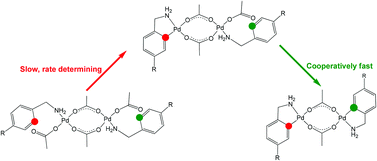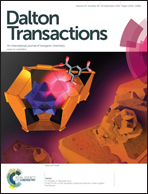A kinetico-mechanistic study on the C–H bond activation of primary benzylamines; cooperative and solid-state cyclopalladation on dimeric complexes†
Abstract
The cyclometallation reactions of dinuclear μ-acetato complexes of the type [Pd(AcO)(μ-AcO)L]2 (L = 4-RC6H4CH2NH2, R = H, Cl, F, CF3), a process found to occur readily even in the solid state, have been studied from a kinetico-mechanistic perspective. Data indicate that the dinuclear acetato bridged derivatives are excellent starting materials to activate carbon–hydrogen bonds in a facile way. In all cases the established concerted ambiphilic proton abstraction by a coordinated acetato ligand has been proved. The metallation has also been found to occur in a cooperative manner, with the metallation of the first palladium unit of the dimeric complex being rate determining; no intermediate mono-metallated compounds are observed in any of the processes. The kinetically favoured bis-cyclopalladated compound obtained after complete C–H bond activation does not correspond to the final isolated XRD-characterized complexes. This species, bearing the classical open-book dimeric form, has a much more complex structure than the final isolated compound, with different types of acetato ligands.


 Please wait while we load your content...
Please wait while we load your content...